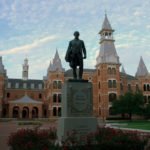Ivy League Schools in New York: 12 Top Colleges
What’s Covered:
- Are There Ivy League Schools in New York State?
- Key Facts About Columbia University
- Key Facts About Cornell University
- Top 10 Non-Ivy League Schools in New York
- What Are Your Chances of Acceptance?
In addition to the two Ivy League schools in New York, the state is home to many fantastic institutions of higher education, including two service academies, a number of top liberal arts colleges, and the well-known SUNY and CUNY systems. All of this adds up to a plethora of excellent college and university options for students in the Empire State.
Are There Ivy League Schools in New York State?
Two Ivy League colleges call the state of New York home: Columbia University and Cornell University. The Ivy League is a group of eight prestigious colleges in the Northeast known for their rich histories, excellent academics, and selective admissions.
Although the Ivy League is now synonymous with academic excellence, it actually began as an athletic association. The term “Ivy League” was first used by a sportswriter in the 1930s about football. In the 1950s, it became the official name of an NCAA athletic conference composed of the eight schools that make up the Ivy League today: Harvard, Yale, Princeton, Columbia, Brown, Dartmouth, Cornell, and the University of Pennsylvania.
Key Facts About Columbia University
What is Columbia University known for? Like other Ivy League colleges, Columbia University has a long and storied history. The school was originally called King’s College and it was the fifth of nine colleges originally chartered in the American colonies.
Overview of Columbia Admissions
Location: New York, NY
Undergrad Enrollment: 8,489
Acceptance Rate: 4%
Middle 50% SAT: 1510-1560
Middle 50% ACT: 34-36
CollegeVine ranks Columbia University as the 15th-best school in the nation. In addition to being one of the best colleges in the country, Columbia is also consistently one of the hardest schools to get into—its 4% acceptance rate is among the lowest in the country.
Your chances of gaining admission to Columbia will vary depending on both the strength of your profile and the school you’re applying to. The university’s Fu Foundation School of Engineering is particularly challenging to gain admission to and has extremely stringent academic standards. Conversely, Columbia College has more lenient academic standards and places more weight on a student’s extracurricular activities.
Similar to other Ivy League colleges, Columbia places significant importance on academics. The university also values intellectual diversity—that is, students who have demonstrated success across a broad range of fields, such as AP classes in both STEM and the humanities.
No matter which school at Columbia you hope to attend, a strong essay will give your application a boost. The school looks for submissions that are both highly personal and engaging. Check out our guide to the Columbia essays for some tips on composing responses that will pique the interest of admissions officers.
Columbia Location
Columbia is located in New York City. As Mark Twain said, “Make your mark in New York and you are a made man.” More specifically, Columbia is located in Manhattan, the heart of one of the world’s most recognizable cities.
Columbia’s location provides students with unparalleled access to everything from industry to entertainment. New York is a hub of finance, theater, and media—offering both internships and career opportunities. Professional opportunities are also found in industries such as real estate, health care, and publishing.
New York City also offers an incredible array of cultural experiences. The city is home to Broadway, museums like the Met and MoMA, and some of the most iconic sports franchises on the planet—like the Yankees, Knicks, and Giants. Students are also treated to classic American events, like the Macy’s Thanksgiving Day Parade and the lighting of the Christmas tree in Rockefeller Center.
Columbia Academics
Columbia University is home to three undergraduate schools: Columbia College, the Fu Foundation School of Engineering and Applied Science (also sometimes called SEAS or Columbia Engineering), and the School of General Studies. Through its three schools, the university offers more than 80 majors.
No matter what a student studies at Columbia, the school’s Core Curriculum is at the heart of their education, as it has been for more than a century. Columbia’s Core Curriculum is designed to transcend disciplines and help students develop the tools they need to succeed both in school and in life after college. Core classes are capped at a maximum of 24 students, which ensures students engage with one another and forge friendships.
Engineering students at Columbia take a modified version of the school’s Core Curriculum. The modified curriculum builds critical thinking, debate skills, and respect for other ideas, while also preparing students to become engineers by instilling technical competencies through coursework like calculus, chemistry, computer science, and physics.
Columbia also has a partnership with Barnard College—one of the best schools in New York that isn’t an Ivy. Barnard is an all-women’s college and students from both schools can take classes at both campuses, participate in clubs and events at both universities, and eat in one another’s dining halls.
Columbia Financial Aid
Columbia University practices need-blind admissions, which means they don’t consider a student’s ability to pay during the application process. Columbia will also meet 100% of the demonstrated need of students and do so without the use of loans—need-based aid is given in the form of student work and grants that don’t require repayment.
Students coming to Columbia from families with total incomes under $66,000 annually (and typical assets) aren’t expected to contribute to the cost of attendance. Students from families with total incomes less than $150,000 annually (and typical assets) are able to attend Columbia tuition-free.
Key Facts About Cornell University
What is Cornell University known for? Cornell is the only land-grant university in the Ivy League. Cornell is also a unique blend of both public and private institutions. The university is home to five colleges and schools that receive state assistance:
- University College of Agriculture and Life Sciences
- University College of Human Ecology
- University School of Industrial and Labor Relations
- SC Johnson College of Business: Charles H. Dyson School of Applied Economics and Management
- Jeb E. Brooks School of Public Policy
Because these schools are state-funded, New York residents pay discounted tuition.
Overview of Cornell Admissions
Location: Ithaca, NY
Undergrad Enrollment: 16,128
Acceptance Rate: 8%
Middle 50% SAT: 1510-1560
Middle 50% ACT: 33-35
Cornell has a reputation for relaxed academic standards when compared to other Ivy League institutions. Nevertheless, the school is still incredibly challenging. CollegeVine ranks it as the 14th-best college in the nation.
Each of Cornell’s schools and colleges has its own admissions procedures and requirements, with some being more stringent than others. For example, Cornell’s College of Engineering has rigorous academic standards equal to those of the other Ivies.
Students interested in applying to Cornell’s more specialized schools are well served to have relevant extracurricular activities on their application.
Cornell Location
Cornell’s 2,300-acre campus calls the city of Ithaca home and is located in the heart of New York’s Finger Lakes region. The university offers students an ideal combination of a college town and a gateway to nature. Ithaca is frequently ranked among the best college towns in the United States.
Downtown Ithaca features a pedestrian-only commons with a number of shops, restaurants, and nightlife. It also hosts events like the Downtown Ithaca Apple Harvest Festival in the fall, the Downtown Ithaca Chili Cook-Off, as well as a variety of musical and street performances.
Surrounding the city is an abundance of natural beauty. Ithaca is known for its gorges, hence its popular “Ithaca is gorgeous” tagline. More than 100 waterfalls are found within 10 miles of downtown. Cornell’s campus lies at the southern edge of Cayuga Lake, the largest of New York’s Finger Lakes, and delivers stunning views along with a variety of recreational opportunities.
Cornell Academics
Cornell is home to nine undergraduate schools. As mentioned above, five receive some state funding and are sometimes called “state contract colleges.” The university is also home to four endowed colleges that rely on private support:
- University College of Architecture, Art, and Planning
- University College of Arts and Sciences
- University College of Engineering
- SC Johnson College of Business: Peter and Stephanie Nolan School of Hotel Administration
Cornell offers nearly 80 majors and more than 120 minors through its nine colleges and schools. More than 4,000 courses are offered across all of its academic departments. Cornell’s School of Hotel Administration is considered one of the best in the world and is the only Ivy League program of its kind. It’s also known for its exceptional agriculture program, which is consistently ranked among the best in the nation for agricultural sciences.
Cornell Financial Aid
Cornell practices need-blind admissions and will meet 100% of the demonstrated financial need of its students. About half of Cornell students receive financial aid and the university is focused on affordability, offering packages that prioritize grants and scholarships (which don’t require repayment, work-study, and zero or low student loans).
The inclusion of student loans in financial aid packages is based on total family income. Families with total incomes:
- Less than $75,000 have no student loans
- Between $75,001 and $125,000 have a maximum of $2,000 in loans
- Between $125,001 and $175,000 have a maximum of $4,000 in loans
- More than $175,000, a maximum of $6,000 in loans
It’s worth noting that students who are New York residents attending one of the five state-funded schools receive reduced tuition—in the 2024-2025 academic year, they’ll save more than $20,000 on tuition.
Top 10 Non-Ivy League Schools in New York
|
School |
Location |
Acceptance Rate |
Undergraduate Enrollment |
|
New York, NY |
15% |
800 |
|
|
New York, NY |
13% |
17,200 |
|
|
Clinton, NY |
14% |
2,000 |
|
|
Poughkeepsie, NY |
20% |
2,500 |
|
|
Hamilton, NY |
17% |
3,100 |
|
|
New York, NY |
11% |
3,000 |
|
|
Glen Cove, NY |
20% |
200 |
|
|
Rochester, NY |
41% |
6,500 |
|
|
Kings Point, NY |
25% |
1,000 |
|
|
West Point, NY |
11% |
4,500 |
1. Cooper Union
Location: New York, NY
Acceptance Rate: 13%
Undergraduate Enrollment: 842
In addition to being one of the best non-Ivy League schools in New York, Cooper Union for the Advancement of Science and Art is one of the best colleges for art and architecture in the country. That said, more than half of Cooper Union undergraduates (56%) are enrolled in engineering.
Cooper Union’s Manhattan location is a big draw for students. Its Foundation Building was once the tallest building in Manhattan and today is a National Historic Landmark. The school’s Great Hall has hosted numerous Presidents (from Lincoln to Obama), abolitionists like Frederick Douglass, women’s suffrage leaders like Susan B. Anthony, authors like Harriet Beecher Stowe, and scientists such as Thomas Huxley.
2. New York University | NYU
Location: New York, NY
Acceptance Rate: 9%
Undergraduate Enrollment: 28,012
NYU’s campus in the heart of Manhattan makes many feel like part of the city and provides a sneak peek at life post-college. Living and studying in one of the world’s great cities provides NYU students with seemingly endless opportunities—whether it’s working an internship at one of the numerous global companies that call New York home, visiting a world-class museum like the Met or MoMA, or catching a Broadway show.
In the classroom, NYU also offers excellence. The school boasts a low (8:1) student-to-faculty ratio, has 4 Nobel laureates on staff, and counts 16 MacArthur Fellows (genius grant) among its faculty. Students can pursue more than 270+ fields of study. Upon graduation, students join a large (nearly 700,000 members) and influential alumni network that includes everyone from entertainment icons like director Martin Scorsese and actress Anne Hathaway to economists like Alan Greenspan and historians like Howard Zinn.
3. Hamilton College
Location: Clinton, NY
Acceptance Rate: 14%
Undergraduate Enrollment: 2,037
Hamilton College isn’t just one of the best colleges in New York; founded in 1793, it’s also one of the oldest. Hamilton is one of just a few colleges in the country that offers an open curriculum. Hamilton students are subject to very few requirements and are free to pursue courses that interest them. The college offers 44 majors—or, concentrations as they’re called at Hamilton—ranging from African Studies to World Politics.
Since 1912, all Hamilton students have signed the Honor Code. It’s a pledge to refrain from all forms of academic dishonesty. Those who don’t sign the Honor Code are forbidden from registering for classes.
4. Vassar College
Location: Poughkeepsie, NY
Acceptance Rate: 19%
Undergraduate Enrollment: 2,462
Vassar College was founded in 1861 as a women’s college and became coeducational in 1969; when it did so, it was the first women’s college in the nation to expand its mission to men. Today, the college continues to diversify its student body—37% of the class of 2028 identify as students of color and more than 15% are the first members of their family to attend college. The class of 2028 is made up of students from 44 states and Washington, D.C., as well as 57 countries.
Like Hamilton College, Vassar also features an open curriculum. There are no general education requirements at the school and students are free to choose the courses they’re most interested in. The college offers 50 majors, 68 minors (what it calls correlates), and two dual-degree programs: a Bachelor of Arts/Masters program in Public Health with Columbia and a Bachelor of Arts/Bachelor of Engineering in cooperation with Dartmouth.
5. Colgate University
Location: Hamilton, NY
Acceptance Rate: 14%
Undergraduate Enrollment: 3,193
Colgate University was founded in 1819, making it the 66th-oldest college in the nation. Legend has it that 13 men met in the settlement of Hamilton to found the Baptist Education Society of the State of New York, baking up the enterprise with 13 dollars and 13 prayers—because of this, 13 is thought of as a lucky number at the university.
In addition to being one of the oldest colleges in the nation, Colgate is commonly ranked among the best liberal arts schools in America. At the heart of a Colgate education is the university’s Liberal Arts Core Curriculum (LACC), which is composed of five elements that encourage lifelong learning, thoughtful citizenship, and inclusivity.
6. Barnard College
Location: New York, NY
Acceptance Rate: 8%
Undergraduate Enrollment: 3,223
Although Barnard College isn’t an Ivy League college per se, it has a long-standing relationship with Columbia University. Barnard was originally founded as a response to Columbia’s refusal to admit women. Today, Barnard and Columbia share resources. Barnard students can take classes at Columbia, participate in the university’s extracurricular activities, and eat at its dining halls. This provides Barnard students the best of both worlds—combining the close-knit community of a small college with the resources of a major university.
Barnard is one of the Seven Sisters, a moniker given to a group of historically all-women colleges. It was the first college in New York to offer degrees to women. Barnard continues to serve its mission of providing a high-quality education to female students equal to the education of men and accepts applications from individuals who consistently live and identify as women.
7. Webb Institute
Location: Glen Cove, NY
Acceptance Rate: 15%
Undergraduate Enrollment: 106
Webb Institute is located just 25 miles outside of New York City on a 26-acre campus on the north shore of Long Island. It’s the oldest school devoted to naval architecture and marine engineering in the United States. It offers just one academic option: a dual bachelor’s degree in Naval Architecture and Marine Engineering.
Webb Institute was founded by shipbuilder and philanthropist William H. Webb, who provided free-tuition scholarships to talented students interested in shipbuilding, a tradition that continues today. Every U.S. citizen and Permanent Resident who enrolls at Webb receives a full-tuition scholarship. It also offers need-based aid to help cover other costs of attendance.
8. University of Rochester
Location: Rochester, NY
Acceptance Rate: 40%
Undergraduate Enrollment: 6,580
The University of Rochester has no traditional core curriculum. In fact, there is just one required course: writing. In addition to the one required class, students must complete the requirements of their major and take a cluster—a set of three related courses—in the two academic divisions they’re not majoring in. This system provides an exceptional amount of academic freedom while ensuring students experience classes across disciplines.
Another unique aspect of a University of Rochester education is the Take Five Scholars program. Through this program, students can take a tuition-free year to study a field outside of their major. This provides the chance to explore interests they either didn’t have the time or the bandwidth for while working toward their degree. Since 1986, more than 1,100 students have taken advantage of this distinctive opportunity.
9. United States Merchant Marine Academy
Location: Kings Point, NY
Acceptance Rate: 33%
Undergraduate Enrollment: 947
The United States Merchant Marine Academy (USMMA) is known for its academic rigor, requiring more credit hours for a baccalaureate degree than any other federal service academy. Its core curriculum is demanding and all students are required to spend a year at sea, regardless of their major. Students graduate from the USMMA with a Bachelor of Science degree, a U.S. Coast Guard license, and an officer’s commission in the U.S. Armed Forces.
Like other service academies, graduates of the USMMA have a service obligation. They can fulfill the requirement by working five years in the United States maritime industry with eight years of service as an officer in any reserve unit of the Armed Forces. Or, they can serve five years of active duty in any of the nation’s armed forces.
10. United States Military Academy | Army
Location: West Point, NY
Acceptance Rate: 14%
Undergraduate Enrollment: 4,508
More than just one of the top colleges in New York, West Point is the oldest continuously operated Army post in the U.S. It was first occupied in 1778 and cadets have been trained in engineering at the location since 1794. The academy was created by Thomas Jefferson with the intention of creating a national university founded on science.
There is no tuition to attend the United States Military Academy. In fact, cadets receive an annual salary, room, board, and medical and dental care. Not a bad deal, considering a West Point education is valued at over a quarter of a million dollars. Students must serve a minimum of eight years in the Army after graduation in a combination of Active Duty and Reserve Component Service.
What Are Your Chances of Acceptance?
Whether it’s an Ivy League school like Columbia, a small liberal arts college like Hamilton, or a service academy like West Point, New York’s best colleges are extremely selective. Your personal odds of admission will vary depending on the strength of your profile.
CollegeVine can help you better understand your chances of getting into these great schools. Our free chancing calculator uses metrics like grades, test scores, and extracurricular activities to estimate your odds at over 1,600 schools nationwide, allowing you to build more informed college lists and see how you stack up against other applicants.



